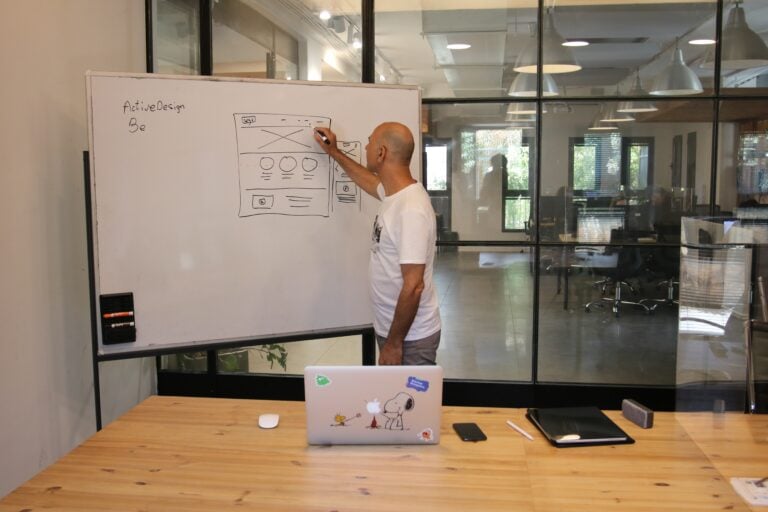Are you are a candidate fascinated by the world of user experience (UX) design? Do you want to create digital products that are not only visually appealing but also intuitive and user-friendly?
In this blog, we will explore what UX design is, the essential skills you need to excel in this field, where you can learn UX design in the UK, mentorship schemes available, and how to land a UX design job.
If you’re an employer looking to recruit, please see our product design and UX recruitment services page for more information about how we work.
What is UX Design?
User Experience (UX) design is a multidisciplinary field that focuses on enhancing user satisfaction by improving the usability, accessibility, and overall experience of digital products. It involves understanding users’ needs, goals, and behaviors, and designing intuitive interfaces that meet those requirements effectively. UX designers work on various aspects, including research, information architecture, interaction design, visual design, and usability testing.
The goal of UX design is to create meaningful and enjoyable experiences for users, ensuring that they can easily navigate through a product, complete tasks efficiently, and achieve their objectives. By applying UX principles, designers can optimise the overall experience and positively impact user engagement, loyalty, and business success.
UX skill set
To be successful within product design and UX, you need a combination of hard skills and soft skills. Hard skills refer to technical abilities and knowledge specific to UX design, while soft skills are personal attributes that enable you to collaborate effectively and communicate with stakeholders.
Hard skills:
- User research: Conducting thorough user research is crucial for understanding user needs, behaviours, and preferences. It involves techniques like surveys, interviews, usability testing, and analytics analysis to gather data that informs the design process.
- Information architecture: Information architecture focuses on organising and structuring content in a way that is logical and intuitive for users. Creating clear navigation systems and hierarchies helps users find information quickly and easily.
- Interaction design: Interaction design involves designing how users interact with a digital product. It includes creating wireframes, prototypes, and defining user flows to ensure smooth and intuitive interactions.
- Visual design: Visual design encompasses the aesthetics and overall look and feel of a digital product. It involves creating visually appealing interfaces, selecting appropriate colour schemes, typography, and graphical elements that align with the brand and enhance usability.
- Usability testing: Usability testing involves evaluating a product’s usability by observing users’ interactions and collecting feedback. It helps identify usability issues and opportunities for improvement, ensuring the final design meets users’ needs effectively.
- UI development: While not always a requirement for UX designers, having a basic understanding of front-end development and coding languages such as HTML, CSS, and JavaScript can be beneficial. It allows designers to communicate effectively with developers and ensures the feasibility of design solutions.
Soft skills:
- Communication: Strong communication skills are essential for collaborating with team members, stakeholders, and clients. Those in UX design must be able to articulate design decisions, listen actively, and empathise with users to create effective solutions.
- Empathy: Understanding and empathising with users’ needs, goals, and frustrations enables designers to create user-centred solutions. Empathy helps designers advocate for the user throughout the design process and create experiences that truly resonate with them.
- Collaboration: UX design is a collaborative process involving cross-functional teams. Being able to work effectively with developers, product managers, and other designers is crucial for creating cohesive and successful products.
- Critical thinking: UX designers need strong problem-solving and critical thinking skills to analyse complex situations, identify pain points, and propose innovative solutions. They must be able to evaluate multiple options and make informed design decisions.
- Attention to detail: Paying close attention to detail ensures that every aspect of the design is considered and optimised. Small details can significantly impact the user experience, and a meticulous approach helps designers create polished and user-friendly interfaces.
- Open-mindedness: Being open-minded allows designers to embrace feedback, accept alternative perspectives, and iterate on their designs. It fosters a continuous improvement mindset and helps designers create better solutions through an iterative design process.
Where can I learn UX design in the UK?
There are various online courses, university programs, qualifications, webinars, and podcasts that can help you learn UX design and acquire the necessary knowledge and skills. Here are some notable resources:
Learn UX design: Online courses:
- Interaction Design Foundation: Offers comprehensive UX design courses, including topics like user research, interaction design, and usability testing. They provide self-paced learning and offer a globally recognised UX design certification.
- Coursera: Provides a wide range of UX design courses from reputable institutions like Stanford University and University of Michigan. Courses cover various aspects of UX design, including research, prototyping, and design thinking.
- LinkedIn Learning: Offers a vast library of UX design courses taught by industry experts. Their courses cover diverse topics, ranging from UX fundamentals to advanced techniques.
Learn UX design: University Courses:
- University of the Arts London: Offers a Master’s degree in Interaction Design Communication, focusing on UX design principles and practices. The program combines theory and hands-on projects to develop students’ skills.
- University of Glasgow: Provides a Master’s degree in Human-Computer Interaction, covering UX design, user research, and interaction design. The program emphasises research and practical application of UX principles.
Learn UX design: Qualifications:
- British Computer Society (BCS): The BCS offers a range of qualifications related to UX design, such as the BCS Foundation Certificate in User Experience. These certifications demonstrate your proficiency in UX design and can boost your career prospects.
Learn UX design: Webinars and Podcasts:
- UXPA UK: The UXPA UK chapter organises webinars and events focused on UX design. They feature industry experts who share insights, case studies, and best practices.
- UX Podcast: A popular podcast that covers a wide range of UX design topics. The hosts invite industry professionals to discuss trends, methodologies, and real-world experiences.
These resources provide valuable opportunities to learn UX design theory, acquire practical skills, and stay updated with industry trends.
UX Mentorship Schemes in the UK
Getting mentorship from experienced professionals can greatly accelerate your growth in this industry. In the UK, several mentorship schemes offer guidance, feedback, and industry insights. Here are some notable mentorship programs to help you learn UX design:
- Design Lab Mentorship: Design Lab offers mentor-led courses where you can learn UX design while receiving personalised guidance from experienced mentors. This hands-on approach helps you refine your skills and build a portfolio.
- MentorCruise: MentorCruise connects aspiring UX candidates with experienced mentors from various design disciplines. They offer personalised mentorship schemes tailored to your needs and career goals.
- The UX Mentor: The UX Mentor provides mentorship programs for those in UX at different stages of their careers. They offer one-on-one mentorship, portfolio reviews, and career guidance to help you succeed in the field.
These mentorship schemes can provide valuable guidance, industry insights, and feedback on your work, allowing you to refine your skills and gain practical knowledge.
How to get a UX design job
Once you have acquired the necessary skills and knowledge in UX design, it’s time to land a job in the field. Here are some steps you can take to increase your chances of securing a UX design position:
- Build a portfolio: Create a portfolio showcasing your UX design projects. Include case studies that demonstrate your process, problem-solving abilities, and the impact of your designs. A strong portfolio is crucial for showcasing your skills to potential employers.
- Network: Attend design conferences, meetups, and industry events to connect with professionals in the UX design community. Networking can help you discover job opportunities, gain insights, and make valuable connections.
- Internships and freelance work: Consider internships or freelance projects to gain practical experience and build your portfolio. These opportunities can provide valuable hands-on experience and help you establish a professional reputation.
- Job boards and online platforms: Utilise job boards like Indeed, LinkedIn, and specialised design platforms to find UX design job openings. Tailor your application and portfolio to the specific requirements of each position.
- Sign up to a specialist product design and UX recruitment agency: this is what we do at Intelligent People so submit your CV to us today.
- Prepare for interviews: Research common UX design interview questions and practice your responses. Be ready to showcase your portfolio, explain your design process, and demonstrate your problem-solving abilities.
- Continued learning: UX design is a rapidly evolving field, so it’s crucial to stay updated with the latest trends, tools, and methodologies. Engage in continuous learning through books, blogs, podcasts, and online communities to sharpen your skills and demonstrate your commitment to professional growth.
Conclusion
UX design is an exciting and rewarding field that combines creativity, empathy, and problem-solving. By understanding the principles of UX design and acquiring the necessary skills, you can create meaningful and user-centric experiences. Explore the online courses, university programs, qualifications, mentorship schemes, and resources available in the UK to start your journey in UX design. With determination, continuous learning, and a strong portfolio, you can position yourself for a successful career in this dynamic field.
As specialist recruiters within product design and UX, we can help you find your dream role. Upload your CV with us, and we will be in touch to discuss suitable roles.




